|
 Extreme Egyptian Masonry:
(Egyptian Masonry Skills).
Extreme Egyptian Masonry:
(Egyptian Masonry Skills).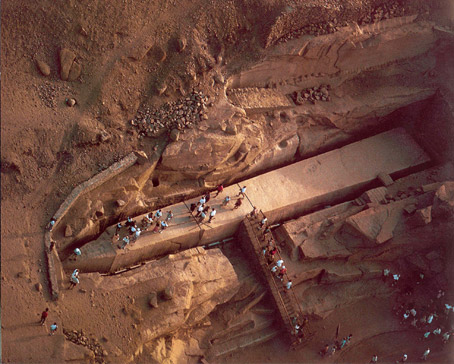
It is not
surprising that the occasional eyebrow was raised in the past
concerning the extent of the Egyptian masonry skills during the
Early dynastic period. Not only were the structures superior in
a visionary capacity, but also in precision, design and
execution. The Dynastic period of Egypt heralded a time of
extraordinary achievement, it was the age of the pyramid
builders when some of the largest and most sophisticated
structures of all time were built, including the last remaining
'Seven-Wonders' of the ancient world, all built in the
Neolithic period.
Although
apparently spontaneous, the technology underlying these huge
constructions and was built on a foundation of science and
mathematics which in turn, has provided us with traces of their
manufacturing processes which are proving equally astonishing.
Quick Links:
|
Machine Tools in Ancient
Egypt: |
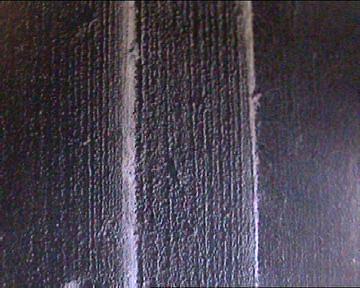 Although the idea was first raised by Petrie, it has resurfaced recently
through the work of Clive Dunn
(1), who provides good evidence of 'Machined'
artefacts at Giza. He reminds us that Petrie also recognised that the few
remaining tools from the period were 'insufficient to explain Egyptian
artefacts'. Although the idea was first raised by Petrie, it has resurfaced recently
through the work of Clive Dunn
(1), who provides good evidence of 'Machined'
artefacts at Giza. He reminds us that Petrie also recognised that the few
remaining tools from the period were 'insufficient to explain Egyptian
artefacts'.
Dunn reviewed certain igneous
artefacts inspected by Petrie and concluded that they 'almost undeniably
indicate machine power was used by the pyramid builders'.
(1)
Egyptologists maintain that
the work (including granite), was completed with copper and stone tools, although this has been contested on the basis that
the spiral tool-marks in
certain core samples indicate that a metal (or precious stone) stronger than copper would have
been required.
The photo (right), is a
close-up of the tool-marks on a granite sample. Their definition, length and
regular separation denote the use of both a harder-than-granite tip, and a
constant pressure.
Core-drilling - There is
plenty of evidence that core-drills
were used at Giza. The classic example being the tool-marks found inside
the sarcophagus of the Great pyramid. As the stone that was being cut is
granite, the surface of the drill-tip would have had to have included a
material of equal or greater hardness in order to cut through the stone.
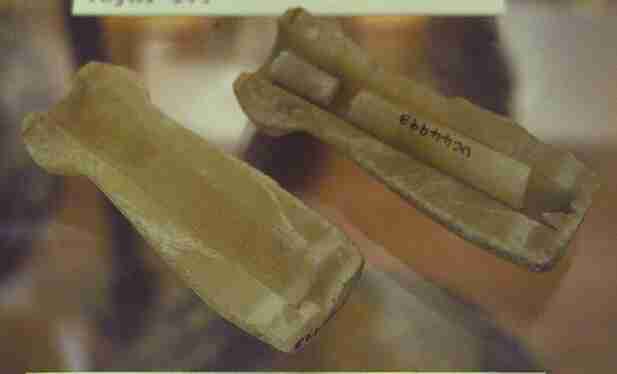 In itself, this is an amazing achievement, but
when we look closer at the remaining drill marks, it is evident that a great
amount of downwards pressure was applied to the drills as well, more than
can be explained by conventional theory. The distance between the grooves
created by core-drilling can be use as a measure of how much force was
applied as drilling was in process. Dunn said of this In itself, this is an amazing achievement, but
when we look closer at the remaining drill marks, it is evident that a great
amount of downwards pressure was applied to the drills as well, more than
can be explained by conventional theory. The distance between the grooves
created by core-drilling can be use as a measure of how much force was
applied as drilling was in process. Dunn said of this
'On the granite core, No 7, the spiral of the
cut sinks 0.1 inch in the circumference of 6 inches, or 1 in 60, a rate of
ploughing out the quartz and feldspar which is astonishing'. The
feed-rate of modern drills, Dunn calculates to be 0.0002 inch per
revolution, indicating that the Egyptians drilled into granite with a
feed-rate that was five hundred ties greater or deeper per revolution of the
drill than modern drills.
(1)
 Mass-Produced lathe-cut vases -
Petrie submitted evidence that showed that the ancient Egyptians used
Lathes. Mass-Produced lathe-cut vases -
Petrie submitted evidence that showed that the ancient Egyptians used
Lathes.
It appears that vase
making was a considerable post in ancient Egypt. We can read an inscription
concerning 'Imhotep' which tributes him as the 'Chief vase maker' amongst
his many titles. There have been literally thousands of stone-carved vases
found in and around Saqqara, which are all
considered to have originated from the first dynastic periods. Many of the
vases have been cut from extremely hard stone, again requiring an equal or
harder blade to cut them with.
The evidence suggests that a specialised drill
would have been used to carve the interiors, which are remarkable in that
they have been carved equally well as the outsides, including the difficult
section inside and under the curve of the 'necks' of the vases.
Dunn
(1), says 'There is also evidence of
clearly defined lathe tool marks on sarcophagi lids'. The sheer scale
of these lids makes this a bold suggestion, which he confidently supports
with the observation that a Sarcophagus lid in the Cairo museum shows
evidence of 'tool marks that indicate these conditions exactly where one
would expect to find them'.
(1)
Experimental Archaeology: Stone Vase
Production.
The suggestion of 'machined' drilling has been
explored by Dennis Stocks, an experimental archaeologist. His
research sheds considerable light on the means whereby stone vases
could be made using equipment available to Egyptians at the time.
The resulting tool-marks have been shown to match those found in
early dynasty stone vases, being produce not by a continuous
revolving drill, but rather with a twist/reverse twist motion
creating two arcs, as produced by using the following hand tool,
rotating left, then right, then left etc. This system provides a
suitable explanation for the production of stone vases made of
alabaster or limestone, but we are still left without a suitable
explanation for the core-drilling seen in granite and obsidian vases
and sarcophagus.

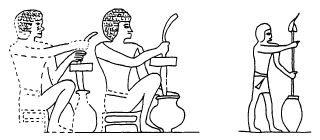
(Left) stone borer, (Right) Images from 12th
and 18th dynasty tombs showing the manual production of vases.
(Link
to Article by Dennis Stocks)
Other Examples:
This schist disc was
discovered at Saqqara. Its purpose is only to be guessed at. It is
approximately 30cm in diameter, and is only 1cm thick.
It is currently on
display in the Cairo museum, and is labelled as an incense container,
although there is no evidence to support this. What is certain is that at
this early time (Early Dynasty period), stone carving is already a sophisticated skill.

This finely carved stone
'funnel' is also from early dynastic Egypt. It is also currently on
display in the Cairo museum.
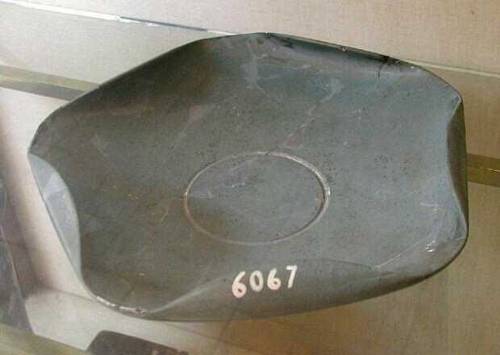
This Schist (slate) plate is from the 3rd
dynasty. It shows the same folded corners as the disc above from
Saqqara. It is also currently on display in the Cairo museum.
|
|
Extreme Masonry at the Giza Plateau: |
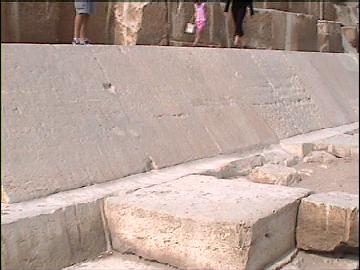
It is often
forgotten that before the pyramid was built, that the limestone
plateau beneath was first levelled, and over it was placed a
platform of carefully cut stones which can still be seen to protrude
from under the pyramids base. This platform is around 0.5m thick and
despite the passing of time and several earthquakes, remains level
to within 0.8 of an inch (21mm) over the entire Giza plateau.
The whole of the
Great pyramid was originally covered with a coat of polished
limestone blocks which would have originally given the
aspect of Giza a
smooth and perfect finish all over. The faces of these blocks have
butting surfaces cut to within 1/100 of an inch of mathematical
perfection.
Petrie said
this of it:
...'the
mean variation of the cutting of the stone from a straight line
and from a true square is but 0.1 inch in a length of 75 inches
up the face, an amount of accuracy equal to the most modern
opticians' straight edges of such a length. These joints, with
an area of some 35 square feet each, were not only worked as
finely as this, but were cemented throughout. Though the stones
were brought as close as 1/500 of an inch, or, in fact, into
contact, and the mean opening of the join was 1/50 of an inch,
yet the builders managed to fill the joint with cement, despite
the great area of it, and the weight of the stone to be moved-
some 16 tons. To merely place such stones in exact contact at
the sides would be careful work, but to do so with cement in the
joints seems almost impossible'.
(7)
Saw-Marks in
the basalt stones on the east side of the Great pyramid at Giza:
The
basalt pavement stones are irregular in thickness, and sometimes
rounded on the bottom side. They were placed on top of blocks of
Tura limestone which had previously been fitted to the
underlying bedrock. It appears from the following photo's that
the basalt blocks were cut to level 'in situ' (after they had
been put in place on the ground).
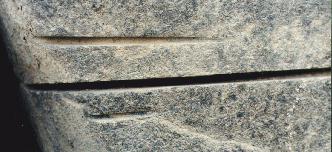
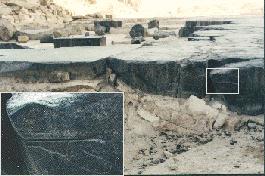
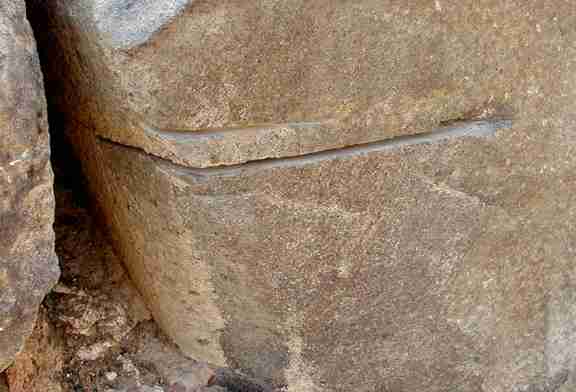
The
crisp and parallel the edges demonstrate the high quality of
this work and indicates that the blade was held completely
steady. It appears that cutting basalt was not so slow and
arduous that extra cuts like these would have been avoided as
being an unnecessary waste of time. There are several places
where over-cuts like these can be seen. If you find this spot,
look around behind you to the north - there are several more
within 30 ft. In one place you can find many vertical parallel
saw cuts right next to each other.
There are several extraordinary sized stones recorded at the Giza plateau,
with the largest regularly estimated at over 400 tons....

Temple East of 'Khafres' Pyramid.
'Largest stone
estimated 468 ton block'
(11).
(J. Cook; The Pyramids of Giza; p. 22). - 'Khafre
foundation stones > 400 tons'.
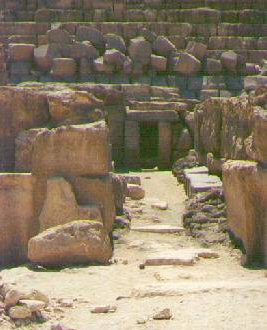
Mortuary temple
of Menkaure
(Mycerinus).
[Edwards, p. 265] - 200 tons
http://atschool.eduweb.co.uk/ - 285 tons
'Reisner
estimated that some of the blocks of local stone in the walls of the
mortuary temple weighed as much as 220 tons, while the heaviest granite
ashlars imported from Aswan weighed more than 30 tons'.
Ref:
http://en.wikipedia.org/wiki/Pyramid_of_Menkaure)
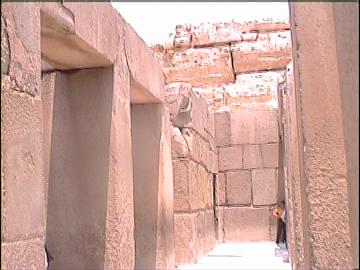
The
'Valley
Temple'
-
The Valley temple was built from huge granite blocks in the style of the Osireion at Abydoss.
They are estimated at around 50 tons + each. The whole temple in turn was encased in
even larger limestone blocks, the largest of which has been (enthusiastically) estimated at
around 200 tons.

The 'Great' pyramid of Khufu - The 'Kings chamber' in the Great
pyramid is covered over with several granite stones estimated at 50-70 tons
each. The Gable stones over the entrance (left) and several of the stones covering
the descending passage are also several cubic metres in size.
Maximum weight of stone in great pyramid:
(Guinness,
p. 119). 50 tons
(R. J. Cook; The
Pyramids of Giza; p. 22).70 tons
(The
largest stones of all time)
|
(More
about the Giza Plateau)
|
Obelisks (Ben-bens and pyramids): |
What is not commonly known is that
all the large 3rd - 5th dynasty pyramids around Giza (The Heliopean
Pyramids) were built so that their corners aligned exactly towards
Heliopois. This architectural fact leads to the idea that the
pyramids were nothing more than large ben-ben's themselves, pointing to the Northern home of the Obelisk, Heliopolis. (In the
South of Egypt, the Obelisk 'Capital' was Karnak).
Hatshepsut's obelisk barge.
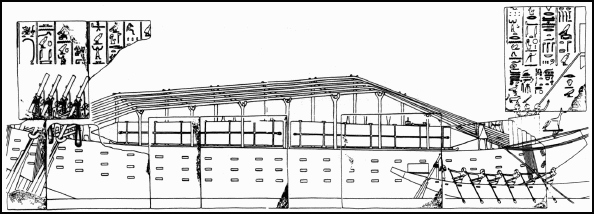
This image
reveals an important engineering factor for moving large stones:
Namely, that they are lighter in water... The transport of heavy
stones by water is suspected at several ancient sites such as
Stonehenge, Giza and Carnac.
Herodotus described moving the
580 ton "Green Naos" under Nectanebo II: "This took three years
in the bringing, and two thousand men were assigned to the
conveying of it ..." (History, 2.175)
Pliny wrote of the
transportation of an "eighty cubit" obelisk under Ptolemy II:
According to some
authorities, it was carried downstream by the engineer
Satyrus on a raft; but according to Callixenus, it was
conveyed by Phoenix, who by digging a canal brought the
waters of the Nile right up to the place where the obelisk
lay. Two very broad ships were loaded with cubes of the same
granite as that of the obelisk, each cube measuring one
foot, until calculations showed that the total weight of the
blocks was double that of the obelisk, since their total
cubic capacity was twice as great. In this way, the ships
were able to come beneath the obelisk, which was suspended
by its ends from both banks of the canal. The blocks were
unloaded and the ships, riding high, took the weight of the
obelisk. (Natural History, 36.14).
(Obelisks and Menhirs Homepage)
|
Concrete in the Pyramids: |
It has been suggested that concrete
might have been used in certain ancient structures. As incredible as it
may seem, there is evidence to support this idea.
In addition to
achieving seamless joins between blocks, the
highly polished limestone casing stones that covered the pyramid
were
fixed with a
'fine aluminosilicate cement'.
The finished pyramid contained approximately 115,000 of these
stones, (Over 13 acres), each weighing ten tons or more. These
stones were dressed on all six of their sides, not just the
side exposed to the visible surface, to tolerances of .01 inch. They
were set together so closely that a thin razor blade could not be
inserted between the stones.
Egyptologist Petrie expressed his astonishment of
this feat by writing: - 'Merely to
place such stones in exact contact would be careful work, but to
do so with cement in the joint seems almost impossible; it is to
be compared to the finest opticians' work on the scale of acres"
'The Hair in the Rock' - Prof. Dr. Joseph Davidovits of the French Geopolymer
Institute discovered a hair sticking out of a boulder of the Cheops
(Khufu) pyramid of Giza.
He concluded that either the hair is older than the rock surrounding
it, meaning the rock formed later, or the boulder is synthetic.
(Either of which is pretty amazing)...
Examination and measurements of the boulders
used in building the pyramid show an unusually high moisture content (similar
to that found in concrete).
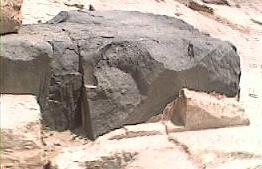
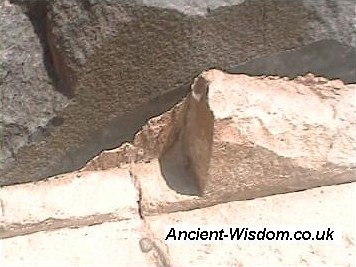
The seam joins between
the basalt and the limestone pavements:
Basalt was used for the paving stones, still visible, in
the Pyramid Temple of Khufu. It is suggested to have come from a quarry in the Faiyum,
west of Dahshur.
(The fine sliver of remaining limestone is
suggestive of either cement or 'moulded' masonry)
Concrete (Torba) is also known to
have been used in the floor of the
Ggantija
temple on Gozo (Malta).
(More about the use of concrete in prehistoric buildings)
One thing that is greatly over-looked is the
incredible sized stones used in the burial vaults of the Pharaohs. It is unclear whether they had much clearance to install these vaults or how they lowered them.
Several 5th and 6th
Dynasty pyramids included gabled roofs with blocks weighing up to 90
tons but the
subject is mostly ignored so it is hard to check facts. Some of them
are known to have a clearance of less than an inch. This may have
involved sliding it in straight in order to get it in place which
would be extremely difficult with a vault that may have weighed over
100 ton.


The Sarcophagus of Amenemhet III , Egypt.
The
quartzite sarcophagus of Amenemhet III weighing 110 metric tons (121
Imperial tons), was placed in a chamber with an interior
length of 7 metres and walls 1 metre thick.
(16)
The monolithic lid was lowered onto the sarcophagus by means of
sand-flow, and the chamber was later covered with another two huge
50-ton limestone vaulting stones.
Above the burial
chamber were 2 relieving chambers. This was topped with 50 ton
limestone slabs forming a pointed roof. Then an enormous arch of
brick 3 feet thick was built over the pointed roof to support the
core of the pyramid.
(26)
The
sarcophagus was found to be empty when opened.
(The
Great Puzzle of Giza: An In-depth analysis of the Great Pyramid)
(Extreme
Masonry from around the Ancient World)
(Prehistoric
Construction Techniques)
(Pyramids
Homepage)
(Prehistoric
Egypt Homepage)
|

 Although the idea was first raised by Petrie, it has resurfaced recently
through the work of Clive Dunn
(1), who provides good evidence of 'Machined'
artefacts at Giza. He reminds us that Petrie also recognised that the few
remaining tools from the period were 'insufficient to explain Egyptian
artefacts'.
Although the idea was first raised by Petrie, it has resurfaced recently
through the work of Clive Dunn
(1), who provides good evidence of 'Machined'
artefacts at Giza. He reminds us that Petrie also recognised that the few
remaining tools from the period were 'insufficient to explain Egyptian
artefacts'.
 In itself, this is an amazing achievement, but
when we look closer at the remaining drill marks, it is evident that a great
amount of downwards pressure was applied to the drills as well, more than
can be explained by conventional theory. The distance between the grooves
created by core-drilling can be use as a measure of how much force was
applied as drilling was in process. Dunn said of this
In itself, this is an amazing achievement, but
when we look closer at the remaining drill marks, it is evident that a great
amount of downwards pressure was applied to the drills as well, more than
can be explained by conventional theory. The distance between the grooves
created by core-drilling can be use as a measure of how much force was
applied as drilling was in process. Dunn said of this Mass-Produced lathe-cut vases -
Petrie submitted evidence that showed that the ancient Egyptians used
Lathes.
Mass-Produced lathe-cut vases -
Petrie submitted evidence that showed that the ancient Egyptians used
Lathes.













